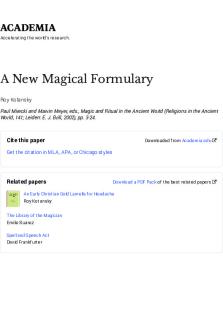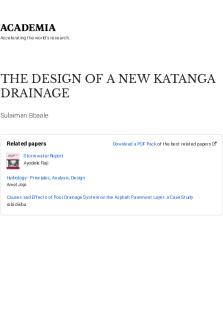DF-wk64404 Describe the process by which new stock (or a new bond series) is issued in order for a company to raise capital. PDF

| Title | DF-wk64404 Describe the process by which new stock (or a new bond series) is issued in order for a company to raise capital. |
|---|---|
| Author | Nelson Ngole |
| Course | Principles of Finance 1 |
| Institution | University of the People |
| Pages | 2 |
| File Size | 81.9 KB |
| File Type | |
| Total Downloads | 808 |
| Total Views | 905 |
Summary
Unit six is a follow up on unit four focused on Managing the Cost of Capital. The unit unfolded with a recapitulation of the concepts of capital cost. In the unit we also learnt about the structuring of stock ownership types, including dividend yields of both common and preferred stocks. Other highl...
Description
Unit six is a follow up on unit four focused on Managing the Cost of Capital. The unit unfolded with a recapitulation of the concepts of capital cost. In the unit we also learnt about the structuring of stock ownership types, including dividend yields of both common and preferred stocks. Other highlights of this unit include bond yield rates and long-term liability structures, which define the enterprise-wide cost of capital, involving the average cost of capital computation. We concluded the unit with a reminder of some unit three concepts, such as the rapport between enterprise-wide cost of capital and capital budgeting constraints. The discussion this week requires us to use the knowledge gained in this unit to contribute and share our thoughts on the topic at hand, which is to describe the procedures for issuing new stocks or bonds in the financial market. Stocks and bonds are financial instruments that can be used by both existing and new businesses to raise capital for their operations. While stocks are shares of a company sold to investors who become owners (based on the number of shares purchased) of the company with some voting rights (Lowrie, n.d.). Bonds, on the other hand, are debt instruments that pay out fixed dividends (Fariña, 2019). According to Lowrie (n.d.), the first step in introducing new stocks into the financial market is to issue a prospectus. This is a document that contains specific company information. This information includes the company's name and that of the director, the company's past performance, the terms of the issuer, and the investment for which the company is raising capital. It also includes the share issue's opening and closing dates, application fees, allotment and on-call dates, bank details for deposits, and the minimum number of shares required to apply. In summary, the prospectus is an open invitation or offer made by the company to the public inviting them to buy shares, similar to an advertisement. (Para2). The second step is to apply for shares: at this point, an application form is issued, and prospective investors can begin applying for shares. The application form includes a fee and a deadline, and the application fee for the share issue is at least 5% of the nominal share amount. The application is made to the company through a bank; the company cannot make any withdrawals until the process is completed. (Para3) The next step in the process is the allocation of shares. In this case, the company's director, in consultation with stock market authorities, will issue a letter of allotment to the applicant, informing him of their willingness to sell the share. This letter specifies the time and date for paying for the shares. It should be noted that not all applicants will receive allotment letters; applicants whose applications did not meet the criterion will not receive allotment letters. Rather, they will be given letters of regret. (para 4). If all of the shares applied for are still pending payment, calls can be made to remind applicants of their allotments. Bond issues, on the other hand, begin with the company (intending to issue bonds) approaching the bank to explain their situation and need for money, according to Fariña(2019). The bank assesses the company's financial situation, determines whether a bond issue is appropriate, and determines whether the company meets the market's essential requirements.(para 1). After that, rating analysis and documentation preparation will take place. A competent rating agency must rate the company in order for it to be eligible to issue bonds. If it does not have one, the bank is required to recommend one after a thorough examination. The bank is keeping a close eye on the entire process. (para2). The third stage, the 'roadshow,' introduces the bonds to potential investors. The process entails holding question-and-answer sessions with investors in major cities around the world. It is also time to learn about the market and how much appetite there is for the company's risk. The operation is pushed forward if the outcome is not in the affirmative. As a result, the goal of the ‘roadshow’ is clear: to engage investors and assess the price range and maturity. (Para 3) The bonds are then placed on the
market in the fourth stage. At this time, the bank and the company are looking for a window of opportunity to set a tentative date, which will be heavily influenced by market conditions. The book is refined after several price adjustments and agreements with investors, issuers, and banks. (Para 4) The allotment and bond prices are the final steps. When the book has been refined and closed, a decision is made as to how much money to give to each investor. This is determined by the investor's quality and the issuer's objectives. Banks provide the issuer with a list of this distribution for approval, and investors are informed of how much they were allocated. (Para5).
References Lowrie L(n.d) procedure of issuing shares in a company. https://yourbusiness.azcentral.com/procedure-issuing-shares-company-28135.html Fariña P M (2019). Step by Step guide of issuing bonds. https://www.bbva.com/en/step-by-step-guideto-issuing-a-bond/...
Similar Free PDFs

A new tab for this
- 3 Pages

A New Magical Formulary
- 490 Pages

A New England Nun
- 2 Pages

A Foreigner in New York - msms
- 41 Pages

THE DESIGN OF A NEW KATANGA DRAINAGE
- 106 Pages

The New Liberal Arts - Grade: A
- 3 Pages
Popular Institutions
- Tinajero National High School - Annex
- Politeknik Caltex Riau
- Yokohama City University
- SGT University
- University of Al-Qadisiyah
- Divine Word College of Vigan
- Techniek College Rotterdam
- Universidade de Santiago
- Universiti Teknologi MARA Cawangan Johor Kampus Pasir Gudang
- Poltekkes Kemenkes Yogyakarta
- Baguio City National High School
- Colegio san marcos
- preparatoria uno
- Centro de Bachillerato Tecnológico Industrial y de Servicios No. 107
- Dalian Maritime University
- Quang Trung Secondary School
- Colegio Tecnológico en Informática
- Corporación Regional de Educación Superior
- Grupo CEDVA
- Dar Al Uloom University
- Centro de Estudios Preuniversitarios de la Universidad Nacional de Ingeniería
- 上智大学
- Aakash International School, Nuna Majara
- San Felipe Neri Catholic School
- Kang Chiao International School - New Taipei City
- Misamis Occidental National High School
- Institución Educativa Escuela Normal Juan Ladrilleros
- Kolehiyo ng Pantukan
- Batanes State College
- Instituto Continental
- Sekolah Menengah Kejuruan Kesehatan Kaltara (Tarakan)
- Colegio de La Inmaculada Concepcion - Cebu









